
Notae is the creation of Jacob Raterman, a college student pursuing studies in French, Foreign Language Education, and Linguistics. His particular enthusiasm for articulatory phonetics, phonology, and graphemics stems from his middle school discovery of the fictional languages and orthographies of J.R.R. Tolkien. Though he has been inventing conscripts for several years, he often became frustrated upon realizing that there was no logical or graphic link between the letterforms he created and the phones they represented. Finally, he conceived Notae, whose graphemes are visually based upon the position of the speech organs during any given articulation, allowing the user to discern the phonetic relationships between sounds through their glyphs. Additionally, he wanted the neography’s characters to be both aesthetically pleasing and minimalistic, as well as easily distinguishable from one another. “Notae” means “marks, notes, signs” in Latin.
Modeled on the American English sound inventory, and therefore includes common AE allophones (/mf/→[ɱ], intervocalic /t/,/d/→[ɾ], /j/→[ç] before /h/). This seemed appropriate due to the frequency of these conventions, but these symbols may be considered auxiliary or peripheral and omitted from everyday use of the script. In addition, Notae also includes the grapheme for /ʍ/, which is the traditional realization of the digraph “wh” but is only currently present in certain American English regional accents. In conclusion, the use of these supplementary graphemes is contingent upon whether the intent of the user is transcriptionally broad or narrow and/or if they exist in that user’s accent.
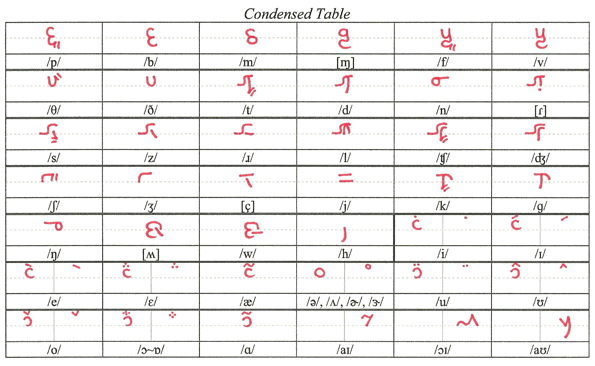
Consonants are formed with a base stroke designating place of articulation plus a secondary stroke denoting manner of articulation. All consonants are voiced by default since they outnumber voiceless consonants in the English sound inventory. A tertiary stroke, the devoicing mark, is appended to the end of the secondary stroke to indicate a voiceless consonant. However, in order to keep the script as simple and efficient as possible, secondary and/or tertiary strokes are not added if there is no need to distinguish between phonemes. For example, since /h/ stands alone as a glottal consonant in English, it is not necessary to add a secondary stroke for manner of articulation, nor a devoicing mark. Similarly, only one palatal consonant /j/ is present in English, so the palatal base stroke suffices to denote this phoneme. If one decides to express the allophonic [ç], then a secondary stroke specifying manner of articulation must be added to the palatal base stroke for /j/ and [ç] to distinguish them. Keep in mind, however, that since [ç] lacks a voiced equivalent, a devoicing mark is omitted.
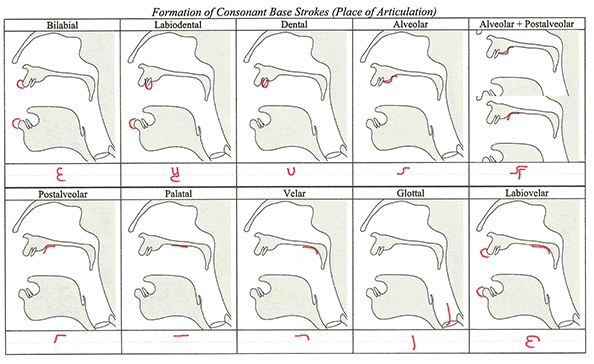
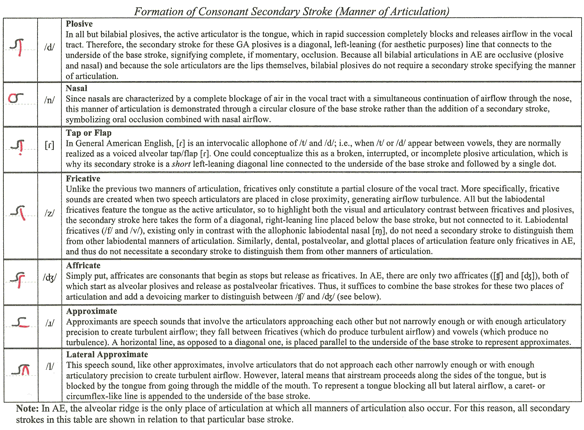

Vowels are formed similarly to consonants, but as the qualification of vowels is considerably less precise than that of consonants (and is normally accomplished through the description of their positions in relation to one another), the components of their letterforms are considerably more abstract. Vowels begin with one of three base strokes indicating backness, plus one of five diacritical marks for height. Vowel roundedness is shown through mirroring the diacritical mark (i.e., ́ becomes ˆ , etc.). The combination of the base stroke and potentially mirrored diacritic constitute vowel graphemes in their composed form. In the spirit of minimalism and efficiency, however, all central vowels are indicated using their unmarked base stroke.
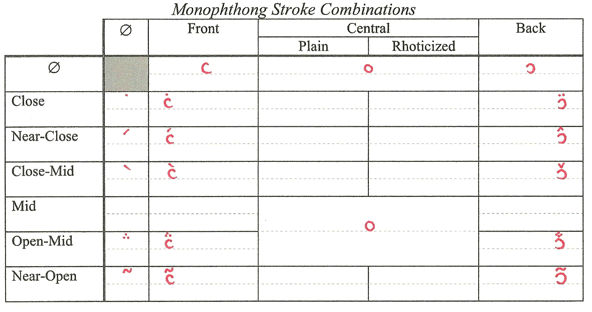
Furthermore, since all but one of the back vowels in American English are rounded, this serves to distinguish them from their front equivalents of varying heights. That is to say, except for near-open vowels, a front-back vowel pair at any given height is invariably unrounded-rounded respectively and thus demonstrates visual contrast through their diacritics. This makes it possible for most vowels to have a diacritical form as well as a composed form; using this diacritical mode, the base stroke is discarded when it is not needed to distinguish between front and back vowels and the appropriate diacritic is placed above the consonant preceding that vowel. For the lowest vowels (front /æ/ and back /ɑ/), both of which are unrounded and employ the same diacritic, the base stroke is necessary: these two vowels only exist in their composed form. This form is also used when a vowel begins a word. The base stroke denoting central vowels becomes a ring-like diacritic. Diphthongs have an obligatory ligatured form originating in the diacritical marks that represent their vocalic loci.

Notae is unicase—no distinction is made between uppercase and lowercase letters. Sentences are marked at the beginning and end, and sentence type indicators are combined between sentences. If a sentence starts as one type but terminates in another (e.g. “I’m going to be on time, but are you going to make your train?”), two different indicators may be used. Comparably, quotations require their own sentence type indicators when encased in or introduced by a quotative utterance.
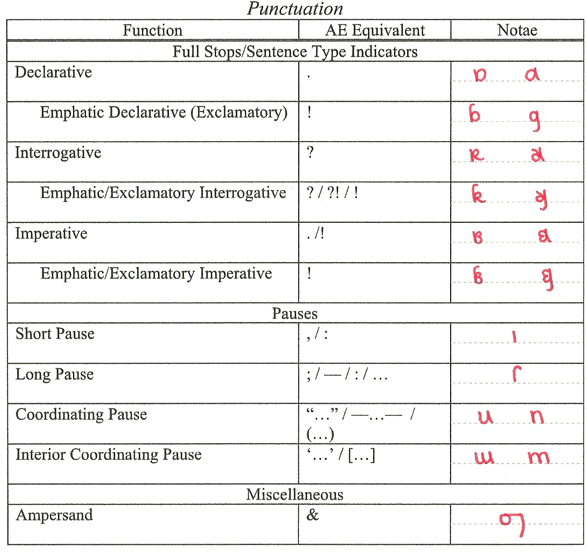
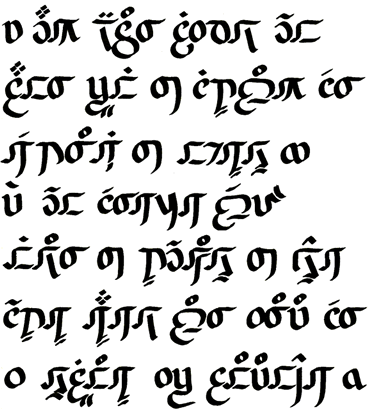
All human beings are born free and equal in dignity and rights. They are endowed with
reason and conscience and should act towards one another in a spirit of brotherhood.
(Article 1 of the Universal Declaration of Human Rights)
Constructed scripts for: Ainu | Arabic | Chinese languages | Dutch | English | Hawaiian | Hungarian | Japanese | Korean | Lingala | Malay & Indonesian | Persian | Tagalog / Filipino | Russian | Sanskrit | Spanish | Taino | Turkish | Vietnamese | Welsh | Other natural languages | Colour-based scripts | Tactile scripts | Phonetic/universal scripts | Constructed scripts for constructed languages | Adaptations of existing alphabets | Fictional alphabets | Magical alphabets | A-Z index | How to submit a constructed script
[top]
You can support this site by Buying Me A Coffee, and if you like what you see on this page, you can use the buttons below to share it with people you know.

If you like this site and find it useful, you can support it by making a donation via PayPal or Patreon, or by contributing in other ways. Omniglot is how I make my living.
Note: all links on this site to Amazon.com, Amazon.co.uk
and Amazon.fr
are affiliate links. This means I earn a commission if you click on any of them and buy something. So by clicking on these links you can help to support this site.
[top]